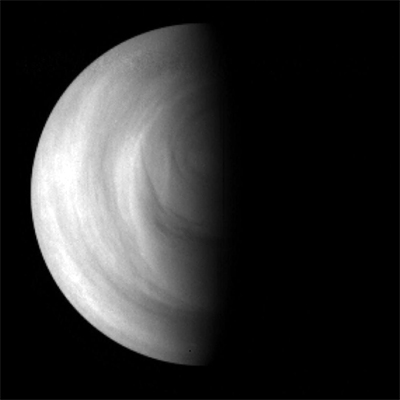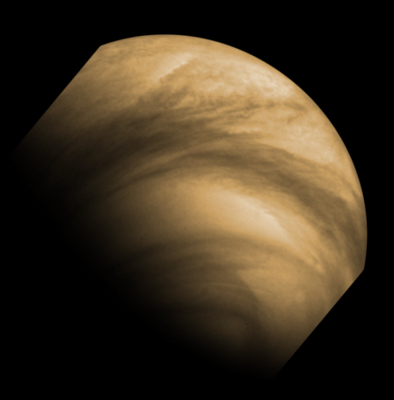- Joined
- Oct 30, 2009
- Messages
- 14,020
- Reaction score
- 4
- Points
- 0
ESA:
Solar flares over, Venus Express restarts science investigations
16 March 2012
ESA’s Venus Express spacecraft has returned to routine operation after its startracker cameras were temporarily blinded last week by radiation from a pair of large solar flares.
Science observations by ESA’s Venus Express were temporarily suspended on 7 March after the two startrackers – used to help navigate and orient the spacecraft – were overwhelmed by excessive proton radiation.
The proton storm stemmed from the Coronal Mass Ejections (CMEs) emitted by the Sun, which were associated with a pair of massive solar flares that occurred early in the morning on 7 March.
 The active Sun Spot group AR1429 (top centre in this image) is a very active solar region that recently produced two major solar flares with coronal mass ejections. The first was an X1-class flare on 5 March 2012 04:13UTC, and the second, even more powerful, an X5-class flare, on 7 March 2012 at 00:28 UTC. Several spacecraft were affected by the resulting strong radiation, wave of solar plasma and energetic particles. For example, the star tracker cameras on board Venus Express were temporarily 'blinded' for several days due to the harsh plasma environment in the aftermath of the CME cloud shock wave.
The active Sun Spot group AR1429 (top centre in this image) is a very active solar region that recently produced two major solar flares with coronal mass ejections. The first was an X1-class flare on 5 March 2012 04:13UTC, and the second, even more powerful, an X5-class flare, on 7 March 2012 at 00:28 UTC. Several spacecraft were affected by the resulting strong radiation, wave of solar plasma and energetic particles. For example, the star tracker cameras on board Venus Express were temporarily 'blinded' for several days due to the harsh plasma environment in the aftermath of the CME cloud shock wave.
With the startrackers unable to function properly, mission controllers at ESOC, ESA’s European Space Operations Centre, Darmstadt, had to place the spacecraft into a special mode to ride out the storm.
Waiting out the storm
This month, Venus Express is going through ‘quadrature’: a period of about five weeks during which the Sun-spacecraft-Earth angle is between 75° and 95°. They occur twice every 19 months.
During quadrature, the spacecraft must maintain a special orientation so that certain instruments are not over-exposed to sunlight and the radio antenna can still be pointed to Earth.
“At any time, if a problem is autonomously detected onboard, the spacecraft might place itself into ‘safe mode’,” says Octavio.
However, if a safe mode were to happen during quadrature operations, and the startrackers were not operating, it would be much more difficult to return the spacecraft to normal operations.
“To be very cautious, we simply stopped science activities to wait out the proton storm,” says Octavio.
The mission operations team used the gyroscopes to maintain a safe attitude while waiting for the startrackers to return to normal.
{...}
Solar flares over, Venus Express restarts science investigations
16 March 2012
ESA’s Venus Express spacecraft has returned to routine operation after its startracker cameras were temporarily blinded last week by radiation from a pair of large solar flares.
Science observations by ESA’s Venus Express were temporarily suspended on 7 March after the two startrackers – used to help navigate and orient the spacecraft – were overwhelmed by excessive proton radiation.
The proton storm stemmed from the Coronal Mass Ejections (CMEs) emitted by the Sun, which were associated with a pair of massive solar flares that occurred early in the morning on 7 March.
Click on image to enlarge
 The active Sun Spot group AR1429 (top centre in this image) is a very active solar region that recently produced two major solar flares with coronal mass ejections. The first was an X1-class flare on 5 March 2012 04:13UTC, and the second, even more powerful, an X5-class flare, on 7 March 2012 at 00:28 UTC. Several spacecraft were affected by the resulting strong radiation, wave of solar plasma and energetic particles. For example, the star tracker cameras on board Venus Express were temporarily 'blinded' for several days due to the harsh plasma environment in the aftermath of the CME cloud shock wave.
The active Sun Spot group AR1429 (top centre in this image) is a very active solar region that recently produced two major solar flares with coronal mass ejections. The first was an X1-class flare on 5 March 2012 04:13UTC, and the second, even more powerful, an X5-class flare, on 7 March 2012 at 00:28 UTC. Several spacecraft were affected by the resulting strong radiation, wave of solar plasma and energetic particles. For example, the star tracker cameras on board Venus Express were temporarily 'blinded' for several days due to the harsh plasma environment in the aftermath of the CME cloud shock wave.
Credits: ESA/ Michel Breitfellner, Miguel Pérez Ayúcar, Manuel Castillo - ESAC
With the startrackers unable to function properly, mission controllers at ESOC, ESA’s European Space Operations Centre, Darmstadt, had to place the spacecraft into a special mode to ride out the storm.
Waiting out the storm
This month, Venus Express is going through ‘quadrature’: a period of about five weeks during which the Sun-spacecraft-Earth angle is between 75° and 95°. They occur twice every 19 months.
During quadrature, the spacecraft must maintain a special orientation so that certain instruments are not over-exposed to sunlight and the radio antenna can still be pointed to Earth.
“At any time, if a problem is autonomously detected onboard, the spacecraft might place itself into ‘safe mode’,” says Octavio.
However, if a safe mode were to happen during quadrature operations, and the startrackers were not operating, it would be much more difficult to return the spacecraft to normal operations.
“To be very cautious, we simply stopped science activities to wait out the proton storm,” says Octavio.
The mission operations team used the gyroscopes to maintain a safe attitude while waiting for the startrackers to return to normal.
{...}




